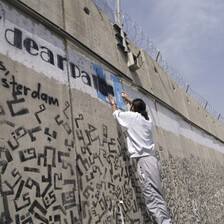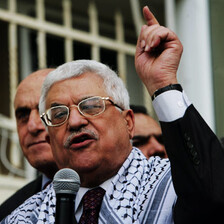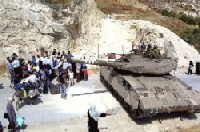
Naser Ishtayeh/AP Photo
‘Israel creates its own demographic threat’, a friend says. ‘Wait, after nine months, you will see’. My aunt in Ramallah told me the story of one of her neighbours. During the curfew she was standing in her garden. An Israeli military jeep passed by and shouted to her: ‘Get inside or we shoot and kill you’. She shouted back to them: ‘Well, you better kill me here outside in the garden, because if I’m forced inside my home, I will kill my husband’. Apparently, also the number of divorces is on the rise.
Imagine, the meaning of curfew. The imposition of a curfew is in theory an extraordinary and temporary measure. Round-the-clock curfews, which suspend civil life altogether and bring it to a complete halt.
A lawyer could tell you that international law requires the occupant to carefully balance security interests with humanitarian safeguards and that curfews may not be used as a measure of collective punishment or reprisal.
Furthermore, he or she will tell you that they may not be illegally administered as a method of control on the pretext that more extreme violations of human rights are the only alternative. The military occupier may establish its control only within the limits prescribed by international law.
Anyone who has visited occupied Palestine and has experienced curfews understands that there has been a consistent pattern of extending curfews well beyond any period which could legitimately be justified as security related. During curfews, the occupation army has taken measures against the entire Palestinian population which clearly exceeds their security interests.
Even under the best circumstances, a curfew will disrupt the lives of people who are not themselves subject to the measure, whether this is because they cannot get to work, schoolteachers are absent, or the local hospital is inaccessible during a medical emergency. For those actually under curfew, civil life simply comes to a complete halt as every person is confined to their home.
Just some figures, chronic and acute malnutrition is widespread among Palestinian children under the age of five and increasing rapidly. More than thirty percent of the entire Palestinian population under occupation are dependent on food handouts from the World Food Program and the International Committee of the Red Cross and other non-governmental organisations. The number of Palestinians requiring food assistance is increasing daily. Around fifty percent of the Palestinian population living under occupation indicate they needed to borrow money to purchase basic foodstuffs, with sixteen percent selling assets for the same purpose.
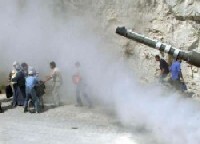
Abed Omar Qusini/Reuters
Availability of immunisation has decreased. Interruptions in electricity supply make medical facilities unable to maintain cold storage and cause vaccines to spoil, further aggravating growing health concerns. The child immunisation program is breaking down.
According to the World Bank, seventy percent of Palestinians living under Israel’s military occupation live below the poverty line of less than $2 per day. In April 2002, the World Bank estimated fifty percent of Palestinians were below the poverty level. The United Nations defines sixty-two percent of Palestinians living under occupation as ‘vulnerable,’ or in need of food, shelter, and or access to health services.
Humanitarian agencies have expressed their concern about unsanitary living conditions and questionable water supply. Thirty percent of the Palestinians living under occupation reported diarrheal characteristics among at least one of its members during the first two weeks of June.
Curfews and closures cause ambulances to require 6 - 8 hours on average to transport patients to hospitals, if they obtain access at all. Twenty-eight percent of the households in occupied Palestine have at least one family member who was not granted access to needed emergency medical services while sixty-seven percent of the households report that access was not granted to at least one family member who required long-term treatment such as dialysis, chemotherapy, or diabetes management.
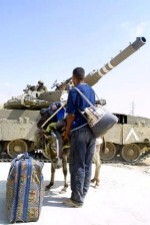
Abed Omar Qusini/Reuters
While the curfew is lifted in one place, it’s imposed in another. This makes travel or movement between cities impossible. What about residents with families living in other cities or towns. These measures disrupt family life, torns families apart, with all consequences it implies.
Isolation have thus become a fact of daily life for the entire Palestinian civilian population living under Israel’s illegal military occupation. It is being applied in an arbitrary and wanton manner on a massive scale without regard for legal norms and humanitarian standards. When security pretexts are offered, they are usually just that -pretexts- intended to obfuscate motives of pressure and collective punishment which lie at the heart of Israel’s colonial policies in the Westbank and Gaza. More importantly, the impact of such policies increases over time. The level of repression need not necessarily be increased in order to have a more injurious effect, this can be guaranteed simply by its perpetuation. In the name of peace and freedom, this forced sequestration of entire communities must end.
- The pictures show an Israeli tank blocking Palestinian residents of Nablus from departing the city to take supplies to friends and relatives outside the city after shopping during a brief lifting of a curfew, Thursday, July 11, 2002. The first picture was taken by Naser Ishtayeh (AP Photo) and the second one showing an Israeli tank firing a smoke screen and blocking Palestinians as they walk home, during a temporary lifting of a curfew, in Nablus, was taken by Abed Omar Qusini (REUTERS).
